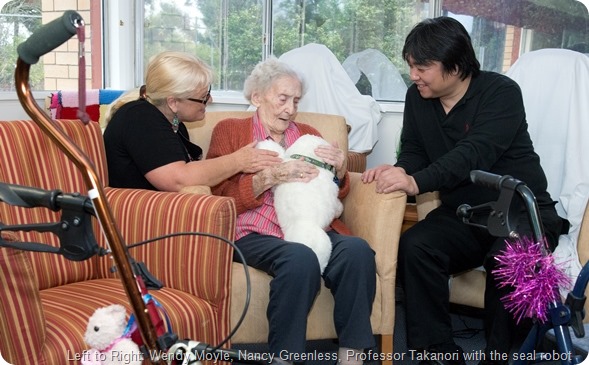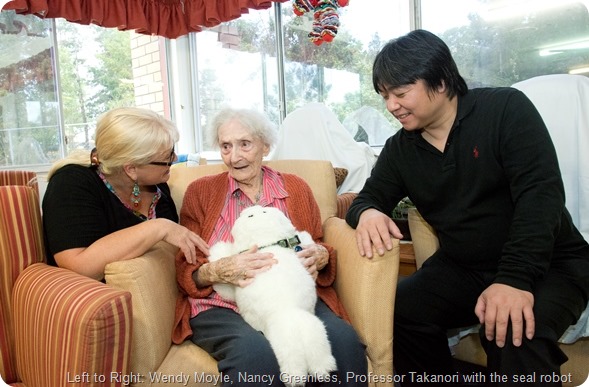
Where did the idea of using animal robots in the treatment of dementia originate?
A robotic cat was first trialled in the US in early 2004 as a companion pet for people with dementia. A number of nursing homes have either ‘toy’ or robotic animals that they use as entertainment for older residents as well as people with dementia.
Although readily available for use there has been limited research conducted on using animal robots and in particular in using them in a therapeutic or emotional way with people living with dementia. Furthermore, previous studies such as those conducted by the developer of Paro have been limited by sample as well as design limitations.
What advantages do robotic animals have over traditional ‘toy’ animals?
This is something that we are also interested in as to date the research has not looked at a comparison between ‘toy’ (non-robotic) animals and robotic animals. However, our preliminary research has found that the robotic features of Paro assist the person with dementia to engage.

Professor Takanori is in Australia from Japan to meet with Professor Wendy Moyle to talk about the robots for dementia. At Sinnamon Park Retirement Village.
For example, when Paro turns when called and responds positively to touch we also observe the person with dementia connecting with the robot to encourage the Paro to respond with them again.
Why do you think there has been limited research on using animal robots in a therapeutic way?
It appears that some members of society are not keen to see robots used in health and social care and this has probably had an influence on opportunities, including access to funds to research their use.
For example, when first seeking funds for our research we were challenged by several health professionals who expressed fears that they felt we were trying to replace the role of the carer with robots. This was in spite of our reports and protocol that demonstrated the robot was to be used as an adjunct to the carer role.
Also until people see the robotic features of some of our robotic animals they imagine that they are stuffed toys and they express concerns about giving toys to older people.
This type of research requires considerable funds to fund not only the purchase of the Paro but also the research trial. So naturally when funds are not available this will reduce the number of trials conducted.
Please can you give a brief introduction to “Paro” the robotic seal?
Paro was developed by Takanori Shibata, a researcher at Japan’s National Institute of Advanced Industrial Science and Technology. Paro is a therapeutic, pet-type robot with the appearance of a baby harp seal.

Paro has tactile sensors and moves its tail and flippers and will respond by opening its eyes and moving its face toward the sound of voice. Paro’s sensors monitor sound, light, temperature and touch and Paro respond’s appropriately, such as responding to its name and being stroked.
Paro can show various emotions including surprise, happiness and anger, and Paro will cry if it is not receiving sufficient attention.
Why was a seal developed over a more traditional pet such as a dog or cat?
Some people have a fear of cats or dogs for example, whereas Paro is a neutral animal, and certainly not one that people tend to have fears of. The Paro shape and size is approximately the size of a new-born baby so we find this also allows the individual to hold Paro and to place Paro on their shoulder or lap just as they would with a new born baby.
To date we find that the people involved in our research tend to look at Paro with surprise and seek to understand what it is. We have not had anyone who has been fearful of Paro. When using robotic animals in a group situation we find some people will prefer a cat but to date we have not compared reactions to our assortment of robotic animals.
What symptoms of dementia does Paro treat?
Our preliminary research has shown that Paro stimulates and engages people with dementia, and with some individuals this has helped them to communicate their emotions. Furthermore, we have found that Paro reduces anxiety, and improves mood states.
How do you think Paro produces these effects?
Paro engages an emotional response as it reacts to people responding to it. For example, it will respond when called and react peacefully when an individual shows it attention. Stroking Paro can be soothing but the feature that seems to draw people to Paro is its eyes; it blinks its long eyelashes and looks directly into the face of the person who has spoken to it.

However, it is not only people with dementia who find Paro induces a relaxing response. For example, I have been in situations in my university and at conferences where academics will pick up the Paro and talk with it as though it is a human form. Even as adults we enjoy play and Paro offers this opportunity in a comforting way.
How do you plan to evaluate Paro’s benefits?
We plan to build on our research with a larger sample of participants and to consider the effect of the robotic features, and contribution of the robot to communication and social interaction.
Our research will use a mixed method approach that will capture the effects using both quantitative outcomes, and qualitative observations and interviews.
Please can you outline current dementia treatments? How does this animal robot compare to them?
People in mid to late stage dementia will often present with behaviours related to their dementia that cause stress for the person and those who care for them. For example, they can display apathy, anxiety, aggression and agitation and this places them at risk of the additional regular use of antipsychotic medication. This is very costly treatment and also increases the risk of stroke, confusion, falls and mortality.
To date there have been no comparative studies looking at the effect of Paro on pharmacological treatments. Our research will also undertake a cost comparative analysis of Paro to pharmacological use.
Is the aim to use animal robots in addition to traditional dementia care or instead of?
The aim is to use Paro (and other robotic animals) in addition rather than in place of other treatments. The aim also is for an individualised approach to using Paro and for a protocol to be developed that will help carers to introduce and use Paro.

How much does Paro cost? Do you think this cost will decrease in time?
Paro costs around $5,000 US. The cost of electronic components have been decreasing overtime and therefore it is likely that the cost of Paro may overtime also be reduced, in particular if other similar robots come onto the market.
Where is Paro currently available?
Paro can be purchased from Intelligent System Co., Ltd. http://paro.jp/?page_id=357
Are there plans to develop other animal robots for the treatment of dementia?
We have a number of different animal robots in our research centre that we are trialling and hope in the future that our research will also help developers of robotic animals to further their development of features that we find to be useful.
Do you think animal robots would be useful for treating other conditions?
Yes, the comfort that Paro for example brings to older people will no doubt be useful for young children and in particular may be useful when children are exposed to stressors that cause them pain.
Where can readers find more information?
https://www.griffith.edu.au/
About Professor Wendy Moyle
 Professor Wendy Moyle is the Director of the Centre for Health Practice Innovation (HPI), a research program in the Griffith Health Institute at Griffith University, Brisbane, Australia.
Professor Wendy Moyle is the Director of the Centre for Health Practice Innovation (HPI), a research program in the Griffith Health Institute at Griffith University, Brisbane, Australia.
She is a partner and research leader in a National Dementia Collaborative Research Centre – Consumers and Carers, where the focus of her work is on the impact of social engagement and quality of life for people with dementia, families and carers.
Wendy’s research has evolved around professional practice issues that focus on evidence for practice in the areas of aged care and in particular mental health and dementia. More recently her research focus has been on finding evidence for managing behavioural and psychological symptoms of dementia (BPSD) using controlled trials to test technologies, psychosocial and complementary and alternative medicine interventions.
She is a member of the World Health Organization Consultation Group on the Classification of Behavioural and Psychological Symptoms in Neurocognitive disorders for ICD-11 and the Co-Chair of the International Psychogeriatric (IPA) Nurses’ Special Interest Group, where she recently co-led a revision of the IPA nurses’ guide for BPSD.